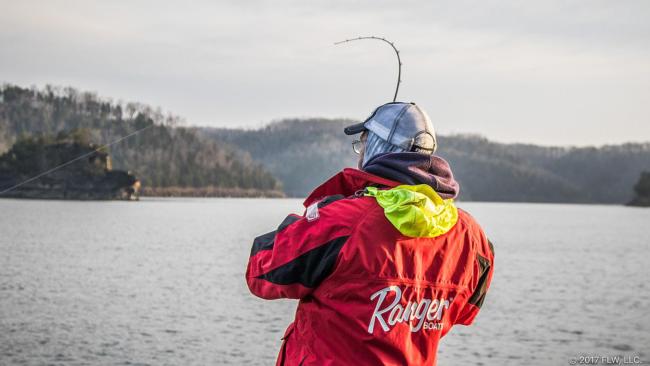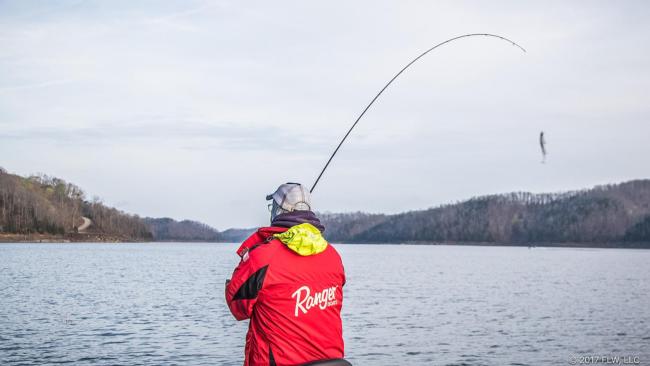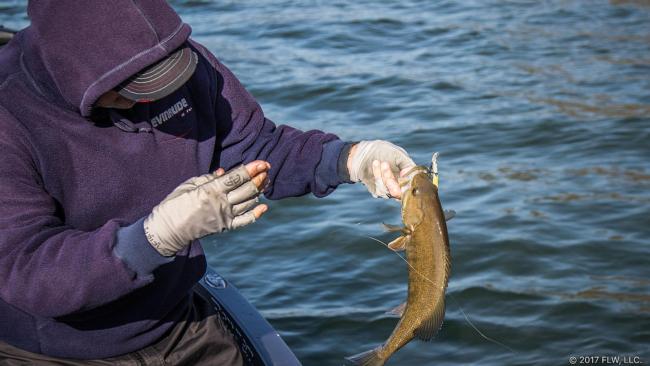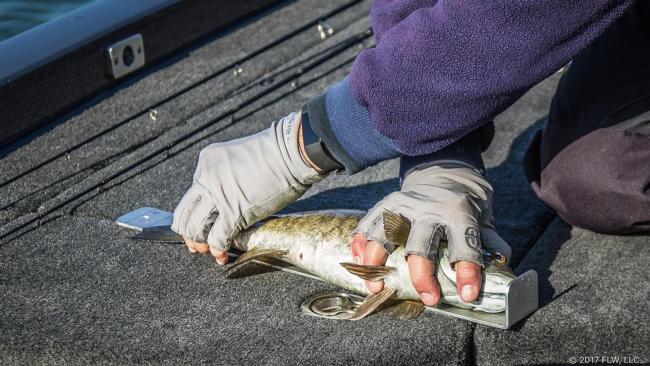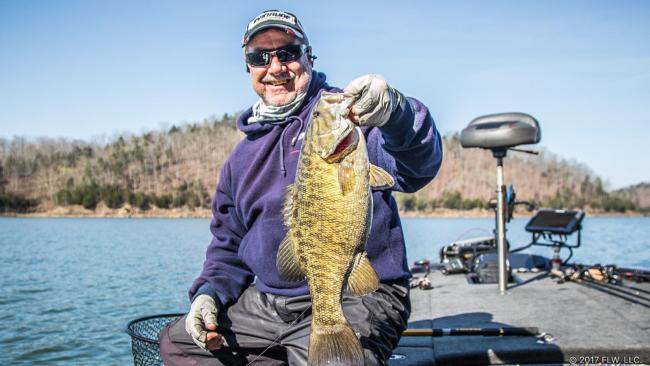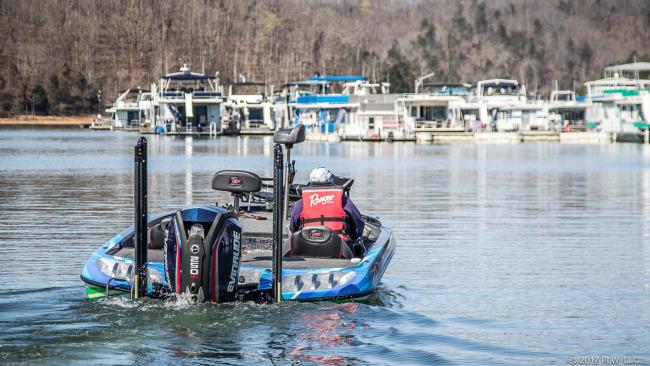A Morning with Nixon on Cumberland
Getting the lay of the lake with the General
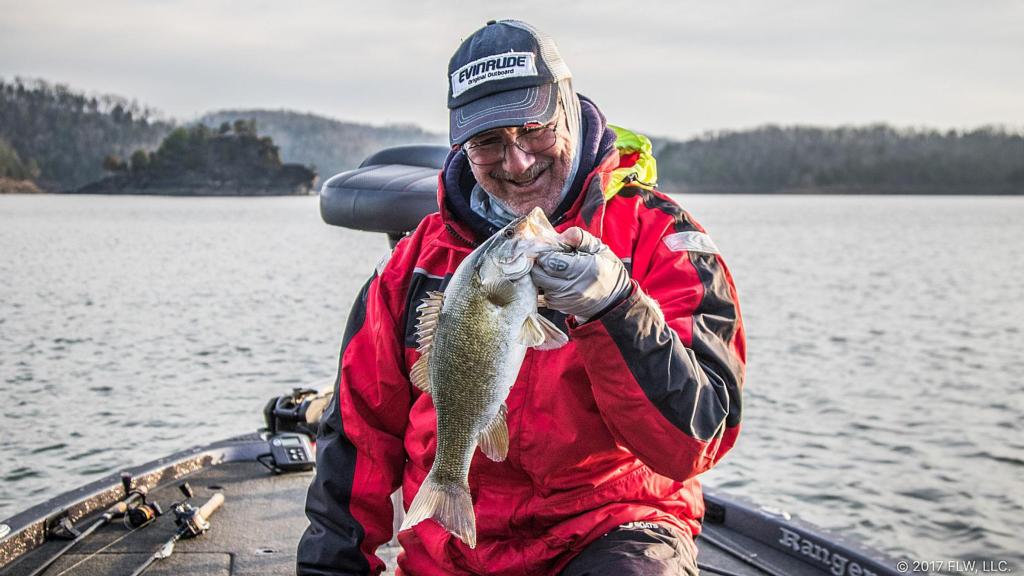
Larry Nixon has had a pretty storied career, but it doesn’t include much action on Lake Cumberland. His one previous trip was back in 2006 for an FLW Series event, and it didn’t go well. He knocked out his lower unit on a floating log about two hours into the first day and limped to the finish from there.
This week, for the FLW Tour event presented by T-H Marine at Lake Cumberland, he’s looking for better results. On day one of practice, Nixon was kind enough to let me tag along for a look at how he breaks things down.
Slipping the boat in at about 7 a.m. ET at Beaver Creek Resort & Marina, Nixon is one of the first five or so pros in the water, beaten only by JT Kenney and Joe Holland at this particular ramp. Back in 2006, he launched here every day of practice, so he’s already got some familiarity with the location. Nixon pulls out a few rods and idles out through the marina before making a short run toward the lake.
Nixon starts on a steep, rocky island in the middle of a horseshoe bend and makes his first cast of the day with a jerkbait. On maybe his second cast he hooks up, and a feisty smallmouth blasts to the surface. After swinging it into the boat (the fish would surely demand a net in competition), Nixon quickly pulls out his board for a measurement. Smallmouths need to be 18 inches to keep on Cumberland, and this one ticks about a quarter-inch past the mark – a solid keeper.
Sliding around the rest of the island, Nixon loses another fish, presumably a smallmouth, and also loses a jerkbait. A few more casts with a new jerkbait result in no bites, so he pulls out a spinning rod with a Ned rig tied on and makes a few casts with that before moving on.
Moving over to where a channel swing transitions to a more gradual bank, Nixon picks up a football head with a Yamamoto Flappin’ Hog trailer and begins to lift and drag it over the bottom and around some of the plentiful standing trees in the lake. A few casts in, Nixon sticks one, wrestles it out of a tree and lands his second keeper of the morning, another healthy 18-inch smallmouth. Moments later, he swings in another. Though a quality fish, this one is shy enough of 18 inches that it goes right back in the lake without a measurement.
“I like clear lakes,” says Nixon, who has caught ’em at nearly every kind of lake in the world by now. “The only thing I don't like about these lakes is you may have to run 50 pockets a day to catch five largemouths. That's just not my style anymore. I'd rather go somewhere and put the trolling motor down.”
Nixon continues down the same bank, away from channel, and shuffles between a small purple and brown jig and a jerkbait. Along the way, he explains that the only surprise so far is the trees in the water. Since his last visit to Cumberland, the lake was drawn down for a significant period of time for dam repair, and that allowed a pile of hardwoods and some cedar trees to sprout up, almost like what pros encountered earlier this season at Lake Travis. At Cumberland, some of the trees are more than 20 feet tall, and they certainly seem like prime bass cover.
Nixon works without a bite to the end of the gradual bank, where it breaks off at a point. He puts down his rod and makes a short move to a small cove about a quarter of the way back into one of the many side creeks. There, he picks up a tube and begins flipping it into the treetops as he works toward the back of the pocket. After each flip, Nixon expertly feeds line, then engages his reel and gives the bait a hop or two before reeling up.
From the sounds of it, it’s not necessarily his favorite thing to do.
“You kind of take yourself out of smallmouths doing this,” relays Nixon. “I don't think they're back in here anyway, but that's why it's called practice.”
After flipping through the back and out of the pocket, Nixon picks up and heads onward.
Still in Beaver Creek, Nixon’s new target is a chunk rock bank that looks pretty perfect. Scott Suggs runs past as we fish down it, and there’s a striper angler nearby, as well, but that’s about it. Though a decent number of pros have run past us toward the main lake throughout the morning, the lake isn’t crowded at all. Cumberland is a vast reservoir with endless coves and shorelines. It can easily swallow up a field of 165 boats, plus some recreational traffic.
After a short idle across a cove, Nixon sticks one with a jerkbait. It fights like a giant for a moment – so hard that Nixon elects to dip it out of the water instead of flipping it. Unfortunately, the battle was deceptive. It’s a quality smallmouth, but it needs to grow about an inch before the Arkansas pro could cart it back to weigh-in at General Burnside Island State Park.
Moments later, Nixon lands his second species of the day, a spotted bass that would easily be a keeper. Like on many lakes with a mix of all largemouths, smallmouths and spotted bass, Cumberland has plenty of spotted bass that can be welcome limit-fillers, but are rarely the winning fish.
Moving on, Nixon stops at a long, shaded 45-degree bank with an awesome combination of chunk rock and stair-stepping rock.
It looks perfect for a crankbait, and that’s what he pulls out.
“I'd just as soon not get a bite here,” says Nixon as he parallels the bank. “This is not one of my fun things to do.”
Before he gets a bite, we come upon a River2Sea Whopper Plopper stuck in a tree. Nixon flips his tube up and snags the bait on his first try, pulls, breaks the line and adds a Plopper in nearly perfect condition to his collection. It almost makes up for losing the jerkbait earlier.
Shortly after retrieving the Plopper, Nixon hooks up with a smallmouth that explodes out of the water. Leaping all around the boat, the fish goes wild. Finally, Nixon digs out the net and lifts a Cumberland special of a smallie into the boat. She goes 5.6 pounds on the scale – a worthy kicker for anyone this week.
The only downside is that Nixon thinks now he might have to crank a little in the tournament.
After releasing the giant smallmouth, Nixon picks up the trolling motor and makes a run away from the section of the creek where he started and into Otter Creek. He picks up a spinning rod again and works over a point. With rock and standing trees scattered around, it looks great, but he comes up empty.
Moving back into a pocket, Nixon swaps the tube for a Texas-rigged Yamamoto Senko. Though he’s working into a pocket, he’s just flipping, not taking any time to get right on the bank and look for possible beds as he works along.
“I didn't see any dogwoods blooming, and that's usually my clue that they're starting to spawn,” says Nixon.
Spring has certainly sprung, though. The redbuds are starting to show, the grass is green in most of the fields and some of the trees are starting to get a little leafy.
Nixon works all the way into the narrow back of the pocket, where he sticks a feisty 2- or 3-pound largemouth on his Senko. The fish thrashes off a tree and across the surface, then quickly into the boat. Cumberland isn’t known for largemouths, but they will no doubt play this week, and could win the tournament. This fish is not the equivalent of an 18-inch smallmouth, but nobody in the field would mind having it.
After a few more flips, Nixon straps his rods down and rolls back toward the ramp to drop me off before continuing his day. As it stands, his plan is to finish out the day in the lower end, but he’s not committed to fishing there yet.
“I hope I don't have to run this far,” says Nixon. “I don't want to run 50 miles. Too many things can happen when you run that far. Back in 2006 I didn't realize how much of the lake I missed. I'm going up there [near takeoff] tomorrow. I know what to fish down here already.”






